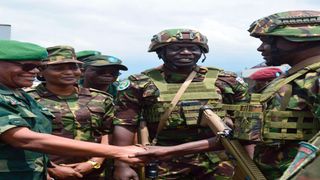
Kenyan troops to Congo being received by the Armed Forces of DRC (FARDC) at Goma International Airport on November 12, 2022.
| Mary WambuiNews
Premium
KDF exit from Congo yields minimal losses, many lessons
What you need to know:
- As Kenyan soldiers have learnt minimal casualties do not necessarily mean success, at least in the eyes of the hosts.
- The exit may have largely been due to a hostile local community which occasionally engaged in violent protests against the EACRF.
When the entire Kenyan contingent of the East African Community Regional Force (EACRF) leaves eastern Democratic Republic of Congo, it will mark a new chapter in the vicious cycle of conflict.
Kenyan troops began withdrawing from the DRC on Sunday, a week after East African Community leaders agreed with Kinshasa to end the EACRF's mandate in the country.
The EACRF would return home with minimal casualties: One life lost in an ambush on a Kenyan base by mortar fire, the source of which remains a point of contention between Congolese forces and M23 rebels.
But as Kenyan soldiers have learnt (the other troop contributors are Uganda, Burundi and South Sudan), minimal casualties do not necessarily mean success, at least in the eyes of the hosts.
When Kenya first deployed in November, President William Ruto personally prayed for the troops and told a gathering in Nairobi that the DRC's problems were Kenya's problems.
“We all have a stake in a stable Democratic Republic of Congo and its security," Ruto said at a send-off ceremony in Nairobi on November 2, 2022.
“These are not responsibilities we can run away from…peace in DRC, peace in Somalia, equals to peace in Kenya," he told Aljazeera in September 2022, days after taking over power.
President Ruto said the United Nations and African Union had backed the deployment and the Defence Ministry said at the time it was mobilising donors to support the cause.
The exit may have largely been due to a hostile local community which occasionally engaged in violent protests against the EACRF. But Kenya learnt that there had been little enthusiasm about the Force, placing the burden on contributors.
A diplomat familiar with the mission told Nation.Africa there had been little funding coming towards the mission even though leaders of some global power houses spoke publicly of supporting peace bids in the Congo.
The funding, insufficient, that came through went to political processes for the Congo, which have also stalled.
One reason for the little enthusiasm in funding the mission, the diplomat explained, was because of the failures of previous missions, including the departing UN Stabilisation Mission in the Congo (Monusco).
“When Monusco announced its departure dates (starting December 2023), many expected that the UN could at least fund the EACRF. But there has been no consensus in the UN Security Council both on the future of EACRF and funding it,” the official said, speaking on the background.
At a UN Security Council session on the DRC in October, the US issued a caveat on funding the EARCF, if it were ever approved.
Linda Thomas-Greenfield, the US Ambassador to the UN, urged Council members to avoid endorsing greater Monusco support to the EACRF “without appropriate safeguards, in line with UN policies to address human rights, accountability, and command and control concerns.”
“These safeguards are vital to ensure we do not inadvertently worsen an already dangerous security situation,” she said.
Regional troops deployed to eastern DRC, whether bilaterally or through the East African Community, she argued, should “coordinate with each other and Monusco. And they must avoid human-rights violations and abuses and illicit activities, including illicit mineral extraction.”
KDF’s lesson was that it was paying for mistakes of others. In fact, the divisions at the UN were not just on the structure of the mission.
There were also about whether the mission as needed at all. Some countries, the diplomat explained, preferred leading the role in the DRC and going through the UN frustrates bilateral decisions.
On a trip to Goma on Saturday, Kenya’s Chief of Defence Forces Francis Ogolla said the troops had followed their mandate.
“I am happy that KENCON (Kenya contingent) troops have undertaken the given EACRF mandate with great responsibility. As KDF we are satisfied to have delivered our role professionally with minimal collateral,” said Gen Ogolla as he visited Kenyan troops at EACRF headquartres in Goma, at their Kibumba Forward Operating Base and Kibati Logistics Base.
“In any international mission, we must always respect and appreciate each other’s values, culture, and customs,” Gen Ogolla said.
Kenya was the first to deploy under EACRF and was followed by Burundi, Uganda and South Sudan. Kenyan troops say they helped protect Goma international airport from rebels, pushed rebels to surrender territories and established relative stability that helped some people return to their homes.
But in the Congo, local politicians rallied with the masses. President Felix Tshisekedi would publicly reprimand then EACRF Commander Jeff Nyagah, whom he told he must beat down M23 rebels.
Tshisekedi followed that with a declaration he won’t renew the mandate of EACRF. The EACRF, however, argued it had little legroom to fire on rebels unless they attacked the mission.
In April, Maj-Gen Nyagah quit his post in a huff, suggesting unknown people had flown drones on his residency to intimidate the troops. It was a new lesson on who else plays big in the Congo.
Nyagah was replaced by Maj-Gen Alphaxard Muthuri Kiugu but EACRF’s perceptions in the DRC did not improve, especially as Congolese elections neared and Tshisekedi needed to explain to the masses why he had not pacified eastern DRC as promised.
One reason EACRF troops may pat themselves on their back is that they will leave without a looting or human rights violations scandal that hit previous missions including Monusco. But it is those mistakes that didn’t help the East African mission.





